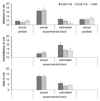Is imagery better than reality? Performance in imagined dart throwing
- PMID: 30913415
- PMCID: PMC6520223
- DOI: 10.1016/j.humov.2019.03.005
Is imagery better than reality? Performance in imagined dart throwing
Abstract
We investigated whether deviations from optimal performance are predicted in motor imagery. In Experiment 1, novices and experts imagined and executed dart throws. In imagination, they reported the final position of the dart. Experts performed better than novices in execution and imagination. Distance to the target and bias were smaller in imagination than in execution. In Experiment 2, we dissociated the roles of feedback from proximal and distal action elements for predictions. Three groups of novices estimated the dart's final position in imagination, in execution without visual feedback, or in execution with delayed visual feedback. Estimates did not differ significantly between groups, indicating that (the lack of) feedback did not influence predictions. Deviations from optimal performance were lower in estimated than in actual performance. In conclusion, although predictive mechanisms may be similar in imagination and execution, the full extent of deviation from optimal performance is not predicted.
Keywords: Action consequences; Darts; Expertise; Feedback; Forward models; Motor imagery.
Copyright © 2019 The Authors. Published by Elsevier B.V. All rights reserved.
Figures








References
-
- Annett J. On knowing how to do things: A theory of motor imagery. Cognitive Brain Research. 1996;3(2):65–69. - PubMed
-
- Beilock SL, Gonso S. Putting in the mind versus putting on the green: Expertise, performance time, and the linking of imagery and action. Quarterly Journal of Experimental Psychology. 2008;61(6):920–932. - PubMed
-
- Berthoz A. The role of inhibition in the hierarchical gating of executed and imagined movements. Cognitive Brain Research. 1996;3:101–113. - PubMed
-
- Blakemore S-J, Wolpert DM, Frith CD. Abnormalities in the awareness of action. Trends in Cognitive Sciences. 2002;6(6):237–242. - PubMed
-
- Boschker MSJ, Bakker FC, Rietberg B. Retroactive interference effects of mentally imagined movement speed. Journal of Sports Sciences. 2000;18(8):593–603. - PubMed
Grants and funding
LinkOut - more resources
Full Text Sources

